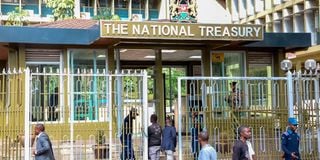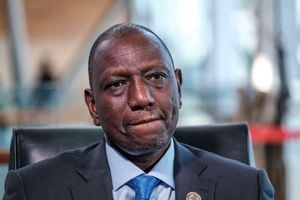
The National Treasury building in Nairobi in this picture taken on March 15, 2023. PHOTO | DENNIS ONSONGO | NMG
The National Treasury is eyeing a return to the external commercial debt market in the 2024/2025 fiscal year, betting on easing financing conditions once the US starts cutting its base lending rate.
In the Draft 2024 Budget Policy Statement, the government says it expects to raise Sh151 billion from a sovereign bond or other commercial financing in the year starting July 2024, which is just under half of the Sh326.2 billion it is targeting in net foreign financing for the budget deficit.
In the current fiscal year, the stated target for commercial loans is Sh175.1 billion, but this has proved hard to achieve due to unfriendly financing conditions externally.
In October, the government secured part of these funds via a $500 million (Sh77.5 billion at current exchange rates) syndicated loan arranged by the Trade and Development Bank (TDB).
In the face of commercial borrowing difficulties, the country has leaned on concessional financing from the International Monetary Fund (IMF) and the World Bank for external financing, with the Treasury expressing a preference for such funding over commercial debt.
“In light of increased cost of financing, the government will continue monitoring the global financial market conditions before accessing the international capital market for any liability management operations,” reads the Budget document in part.
“More emphasis will be to maximise concessional loans while non-concessional and commercial external borrowing will be limited to economic enabler projects that cannot secure concessional financing.”
In the 2024/2025 fiscal year, the State faces a budget deficit of Sh704 billion, which will be financed through domestic loans worth Sh377.7 billion, and external borrowing worth Sh326.2 billion.
These borrowing targets however tend to be revised periodically in the course of a fiscal year, largely because of shifting financing conditions and changes in expenditure and revenue plans.
In the external market, there is expectation that the tough financing conditions that have forced Kenya to shelve plans of floating a Eurobond will ease, once the US starts cutting its base lending rate as expected.
The Federal Reserve, in its December 12-13 meeting indicated that it expects to make three rate cuts next year, which analysts project could shave up to 1.5 percentage points off its current policy rate of 5.25 percent to 5.5 percent.
This rate has climbed from near zero in March 2022 in response to high inflation in the country —which reached 40-year highs of nine percent in mid-2022— but this has since eased towards its two percent target rate.
For smaller economies like Kenya, high US interest rates make it difficult to access international lenders, who demand a high premium to lend to the country instead of the US.
The peak of this risk aversion to frontier markets saw Kenya’s Eurobond yields in the secondary market hit highs of 22 percent in July 2022, before moderating progressively to the current range of 9.8 percent to 13 percent.
These yields are a guide to the risk perception apportioned to an issued by investors and are therefore an indicator of how they would price a new bond floated by the country.









